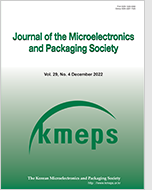
Search
- Past Issues
- e-Submission
-

KCI Accredited Journals KCI 등재지
KCI Impact Factor 0.54
Editorial Office
- +82-2-538-0962
- +82-2-538-0963
- kmeps@kmeps.or.kr
- http://kmeps.or.kr/

KCI Accredited Journals KCI 등재지
KCI Impact Factor 0.54
Journal of the Microelectronics and Packaging Society 2024;31(4):37-46. Published online: Jan, 22, 2025
DOI : doi.org/10.6117/kmeps.2024.31.4.037
AI semiconductors like GPUs, TPUs, and NPUs are crucial for deep learning models, with High Bandwidth Memory (HBM) enhancing performance. The HBM market is projected to grow annually by 46% from 2022 to 2029. To address challenges in semiconductor packaging, such as heat dissipation and signal interference, 3D-IC stacking and glass interposers with Through Glass Via (TGV) technology are emerging as key solutions. TGV improves thermal management, signal integrity, and cost efficiency. This paper discusses recent research trends in TGV manufacturing technologies, such as selective laser etching (SLE), functional layer deposition, and pulse electroplating, which are core technologies for enhancing the reliability and performance of AI semiconductors. SLE technology allows the formation of vias in glass by selectively removing material from a substrate using a laser and an etchant.
Keywords Through Glass Via (TGV), 2.5D Packaging, Etching, Electroplating